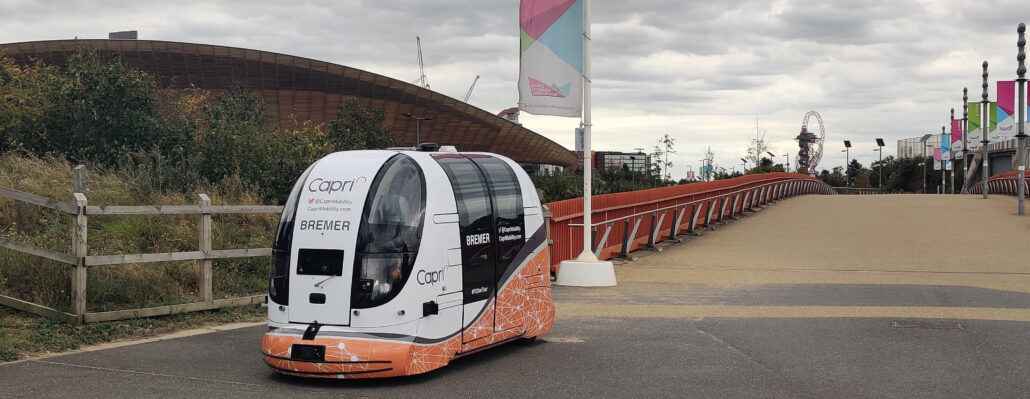
In the development of autonomous transportation, we’re all apprentices
Insight | Dr Colin Black, AECOM. Autonomous vehicles (and AECOM’s London Aldgate offices) played a star role in a recent episode of The Apprentice, where candidates had to pitch branded pods to potential clients. Our future mobility expert Dr Black sheds light on what still needs to be done to roll out this technology into wider society.
When the producers of one of the BBC’s biggest shows called and asked whether they could feature autonomous pods from a project we’ve been recently working on, along with our colleagues at Westfield Autonomous Vehicles, we were initially hesitant. It’s not that we didn’t want to raise the profile of future mobility, but when we say that profile would be in the hands of nine candidates vying to be Lord Sugar’s apprentice, you’ll understand why.
Nevertheless, we decided to go for it, with the candidates being tasked to brand their own autonomous pods and much of the filming undertaken at AECOM’s London Aldgate offices. Like most viewers, I cringed my way through the episode as the candidates pitched their branded pods to a range of potential clients – and very good sports – including AECOM clients High Speed 2 (HS2) and Network Rail, with some success.
But what happens on The Apprentice stays on The Apprentice. While the pods pitched by candidates will, of course, never see the light of day at HS2 and Network Rail, it does raise the question of whether autonomous pods will soon become a common part of our transport infrastructure?
The episode came about after the show’s producers spotted the AECOM-led Capri Mobility project on the news, which was a research project looking at how autonomous vehicles could work as part of a wider transport system.
Autonomous vehicle technology is already here and well developed, but there are a range of social, legal, and technical issues that will make their wider deployment more challenging to achieve. So, what did we learn from the candidates and how far off the mark were their brands?
One of the most important barriers to consider is public perception. Industry will need to understand their fears, concerns, ideas and aspirations to ensure future services are designed to meet their needs and make them feel safe. What the show demonstrated was that the perception of how pods could potentially be deployed was diverse – from a green transport solution to an experiential activity.
A hugely important discussion about how autonomous transport interfaces with society and technology is currently unfolding and ongoing. The research we’re undertaking in this area has been crucial, as it helps us understand what we need to do, as an industry, to make this technology applicable to real life. These decisions about real life application have to grapple with answers to questions such as what are the right priorities for which types of roads, considering how best to balance the needs of pedestrians, cyclists, autonomous vehicles such as pods, and freight?
These answers will, in turn, raise the question of where investment in autonomous pods is best placed. For example, if its focus is in taking carbon out of the ‘last mile’ of journeys, should we, as a society, pursue in preference current policy to promote active travel modes increasing walking and cycling? As we evaluate the viability of investment returns, we may start to see the focus shift towards other challenges such as the potential to aide freight decarbonisation, or improve the customer experience of mass transit.
“We may start to see the focus shift towards other challenges such as the potential to aide freight decarbonisation, or improve the customer experience of mass transit.”

Societal reactions are often shaped by the media response and decisions will feed into government policy around the roll out of this technology. Mapping the algorithms that control the vehicles with a clear and consistent policy approach will be crucial to enable these systems to realise their potential. Last night’s episode was a tiny part of that discussion, but it will certainly help raise awareness of the debate around how we’ll get around in the future. In the same way those of us of the Tomorrow’s World generation recall the technology introduced to us by Maggie Philbin, it will be interesting to look back on this episode in a decade’s time and see how much it has dated.
In the episode the candidates were tasked with the fun element in the evolution of our deployment of autonomous vehicles, exploring the potential markets. At AECOM we’re working at a wider and deeper level, considering the societal and technological challenges and researching the interface of this technology with the market and regulation. We’re playing a pivotal role in developing our understanding of what we need to do to put autonomous vehicles into operation.
But we’ve got more in common with those on The Apprentice than you might think. Just like Lord Sugar, we’re looking for a diverse range of the brightest and most innovative minds to join us and help society navigate what the future might look like. And just like the candidates, there’s still so much to learn about the part autonomous vehicles will play in our mobility future, that it’s fair to say we’re all still apprentices.
End.
This is an edited version of an article that first appeared in New Civil Engineer’s online edition.
Green Infrastructure Week, sponsored by AECOM, curates’ content from the entire ecosystem around green infrastructure from government and NGOs to respected commentators.
Feel free to share this content with your social media community using #GreenInfrastructureWeek
During Green Infrastructure Week we will host a programme of live and exclusive free-to-attend webinars. Stay in touch with event updates by registering here.